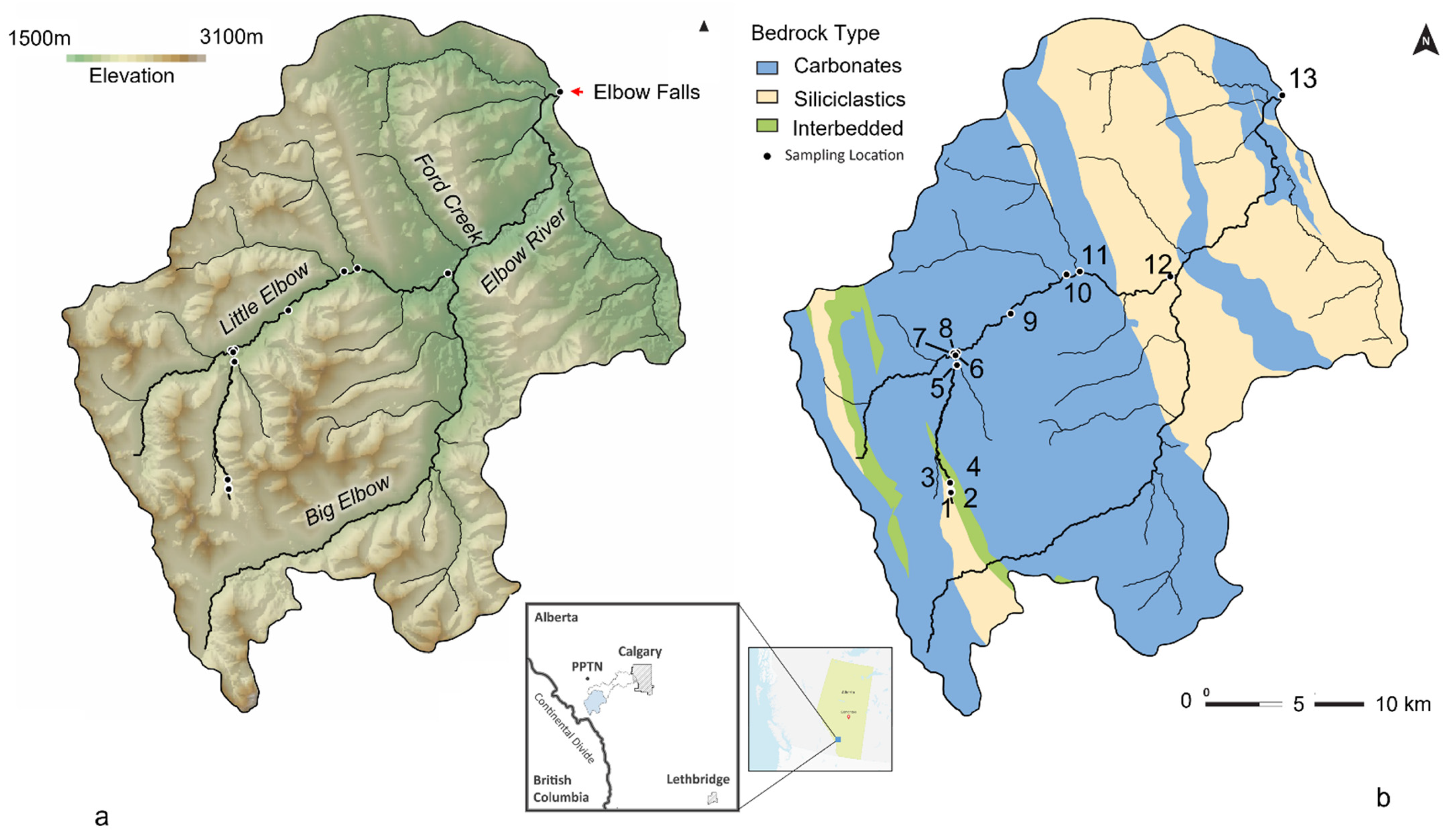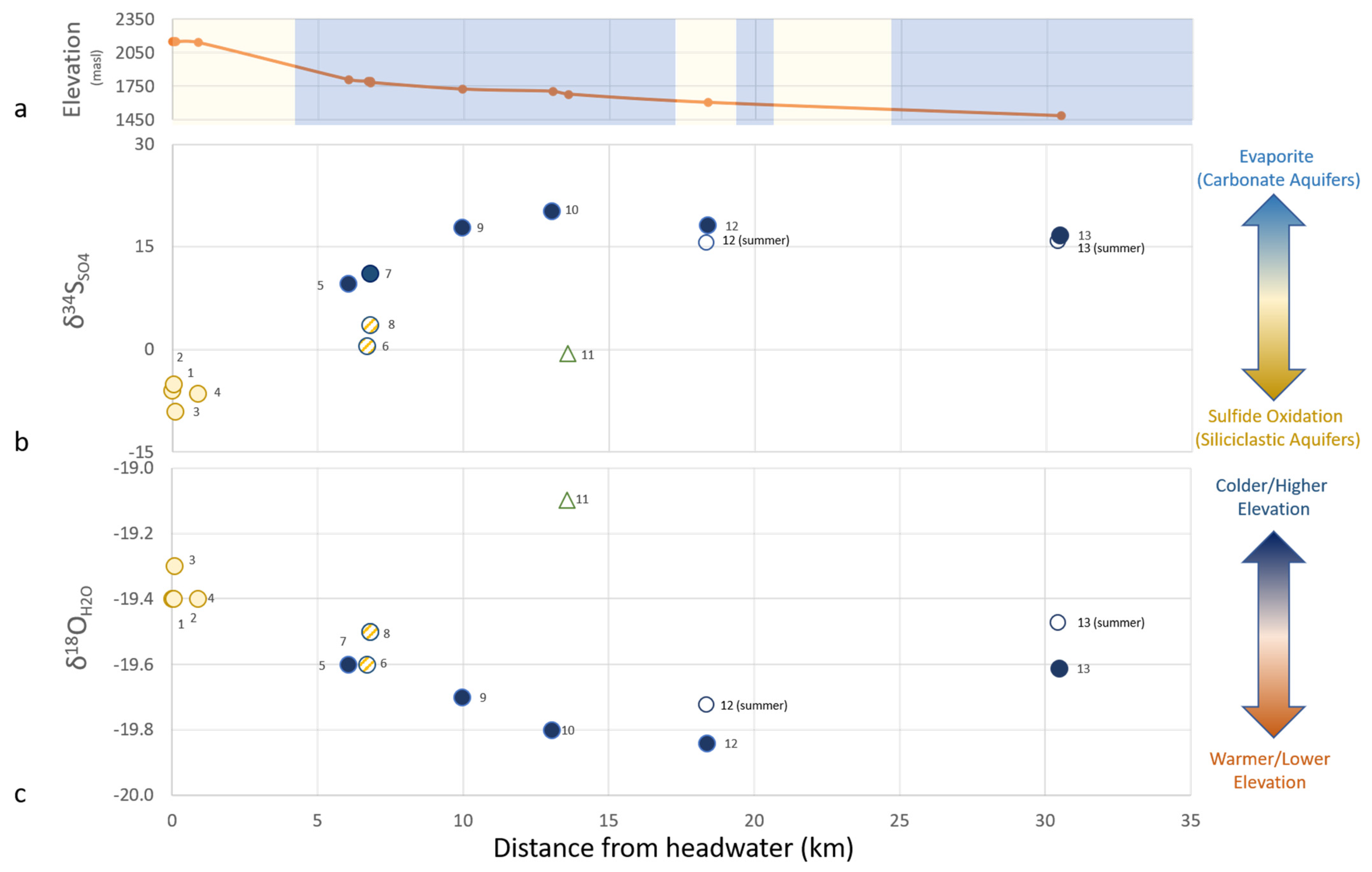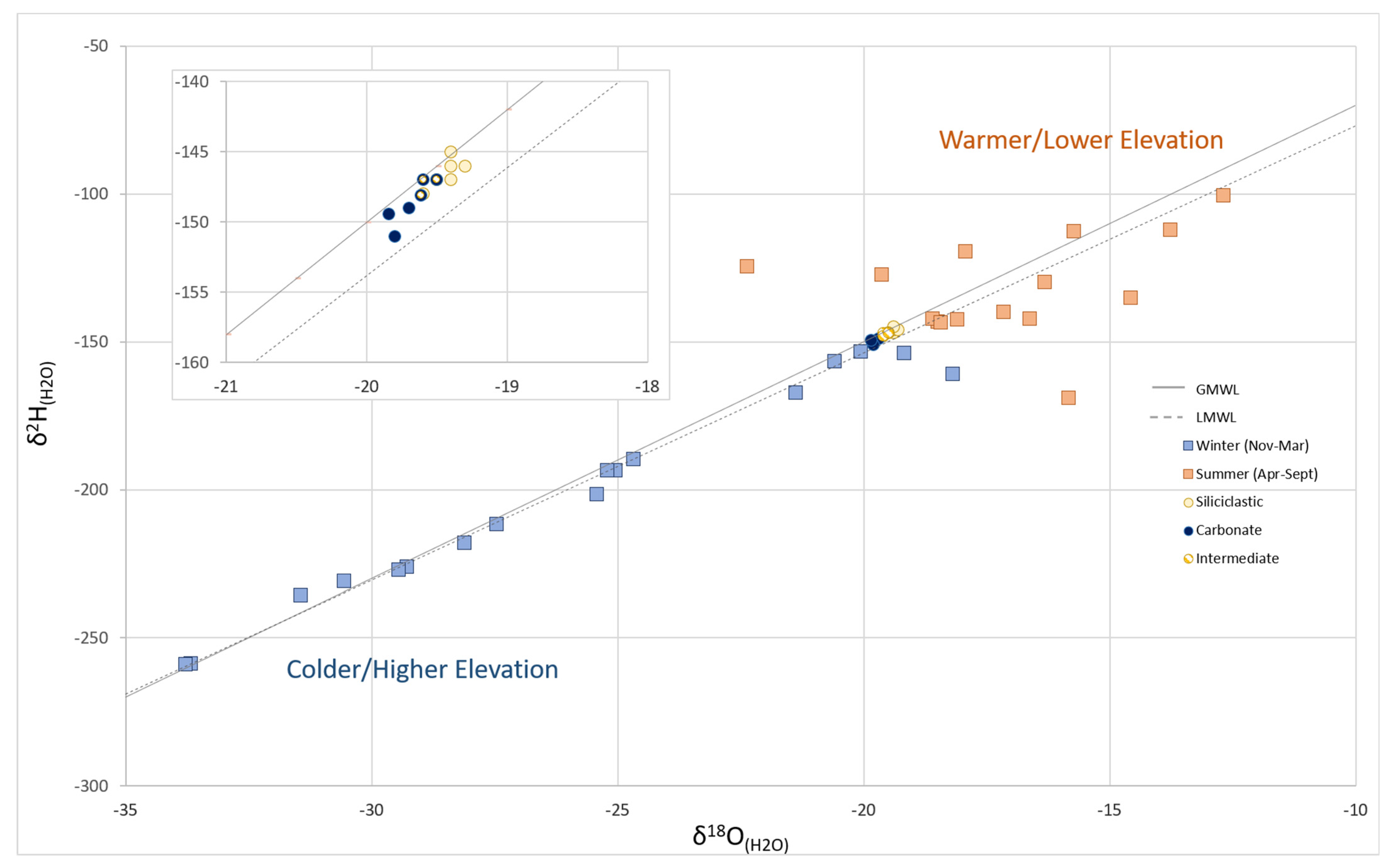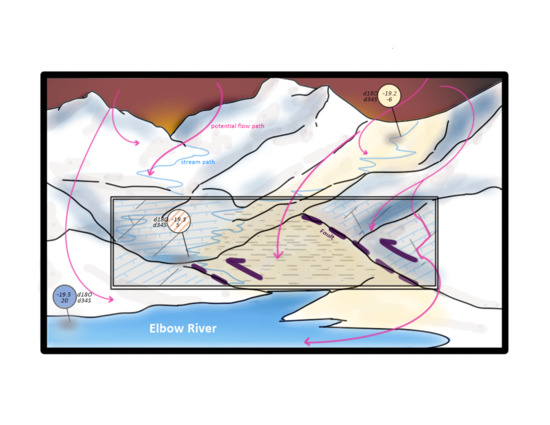Nested Recharge Systems in Mountain Block Hydrology: High-Elevation Snowpack Generates Low-Elevation Overwinter Baseflow in a Rocky Mountain River
Abstract
:Highlights
- Nested flow systems convey higher-elevation/colder precipitation to lower-elevation river reaches;
- Winter baseflow is generated mainly from winter precipitation stored and transported through carbonate aquifers;
- Long flow pathways for high-elevation precipitation suggest little difference between intermediate and deep flow pathways and therefore between mountain aquifer and mountain block recharge;
- Dependence on winter precipitation leaves the river vulnerable to climate change.
1. Introduction
- Assess relative contributions of aquifer types to baseflow;
- Assess relative temperature and elevation of precipitation contributing to baseflow along the length of the river;
- Use these assessments to integrate conceptualization of local, intermediate, and deep flow pathways in mountain aquifer and mountain block recharge.
2. Materials and Methods
2.1. Study Area


2.2. Sample Collection and Analysis
2.2.1. Stream Profile and Sample Points
2.2.2. Streamflow Sampling
2.2.3. Laboratory Analysis
2.3. Data Analysis
3. Results and Discussion
4. Conclusions
Author Contributions
Funding
Institutional Review Board Statement
Informed Consent Statement
Data Availability Statement
Acknowledgments
Conflicts of Interest
References
- Viviroli, D.; Kummu, M.; Meybeck, M.; Kallio, M.; Wada, Y. Increasing dependence of lowland populations on mountain water resources. Nat. Sustain. 2020, 3, 917–928. [Google Scholar] [CrossRef]
- Somers, L.D.; McKenzie, J.M. A review of groundwater in high mountain environments. Wiley Interdiscip. Rev. Water 2020, 7, 1–27. [Google Scholar] [CrossRef]
- Pepin, N.; Bradley, R.S.; Diaz, H.F.; Baraer, M.; Caceres, E.B.; Forsythe, N.; Fowler, H.; Greenwood, G.; Hashmi, M.Z.; Liu, X.D.; et al. Elevation-dependent warming in mountain regions of the world. Nat. Clim. Chang. 2015, 5, 424–430. [Google Scholar]
- Musselman, K.N.; Addor, N.; Vano, J.A.; Molotch, N.P. Winter melt trends portend widespread declines in snow water resources. Nat. Clim. Chang. 2021, 11, 418–424. [Google Scholar] [CrossRef] [PubMed]
- Wilson, J.L.; Guan, H.; Phillips, F.M.; Hogan, J.; Scanlon, B.; Agu, W. Mountain-Block Hydrology and Mountain-Front Recharge. Groundw. Recharg. Desert Environ. Southwest US 2004, 9, 113–137. [Google Scholar]
- Markovich, K.H.; Manning, A.H.; Condon, L.E.; McIntosh, J.C. Mountain-Block Recharge: A Review of Current Understanding. Water Resour. Res. 2019, 55, 8278–8304. [Google Scholar] [CrossRef] [Green Version]
- Hayashi, M. Alpine Hydrogeology: The Critical Role of Groundwater in Sourcing the Headwaters of the World. Groundwater 2020, 58, 498–510. [Google Scholar] [CrossRef] [PubMed]
- Christensen, C.W.; Hayashi, M.; Bentley, L.R. Hydrogeological characterization of an alpine aquifer system in the Canadian Rocky Mountains. Hydrogeol. J. 2020, 28, 1871–1890. [Google Scholar] [CrossRef]
- Käser, D.; Hunkeler, D. Contribution of alluvial groundwater to the outflow of mountainous catchments. Water Resour. Res. 2016, 52, 680–697. [Google Scholar] [CrossRef] [Green Version]
- Tóth, J. A theoretical analysis of groundwater flow in small drainage basins. J. Geophys. Res. 1963, 68, 4795–4812. [Google Scholar] [CrossRef]
- Manning, A.H.; Ball, L.B.; Wanty, R.B.; Williams, K.H. Direct Observation of the Depth of Active Groundwater Circulation in an Alpine Watershed. Water Resour. Res. 2021, 57. [Google Scholar] [CrossRef]
- Smerdon, B.D.; Allen, D.M.; Grasby, S.E.; Berg, M.A. An approach for predicting groundwater recharge in mountainous watersheds. J. Hydrol. 2009, 365, 156–172. [Google Scholar] [CrossRef]
- Campbell, É.M.S.; Pavlovskii, I.; Ryan, M.C. Snowpack disrupts relationship between young water fraction and isotope amplitude ratio; approximately one fifth of mountain streamflow less than one year old. Hydrol. Process. 2020, 34, 4762–4775. [Google Scholar] [CrossRef]
- Winter, T.C. The role of ground water in generating streamflow in headwater areas and in maintaining base flow. J. Am. Water Resour. Assoc. 2007, 43, 15–25. [Google Scholar] [CrossRef]
- Paznekas, A.; Hayashi, M. Groundwater contribution to winter streamflow in the Canadian Rockies. Can. Water Resour. J. 2016, 41, 484–499. [Google Scholar] [CrossRef]
- Campbell, É.M.S.; Lagasca, P.A.; Stanic, S.; Zhang, Y.; Ryan, M.C. Insight into watershed hydrodynamics using silica, sulfate, and tritium: Source aquifers and water age in a mountain river. Appl. Geochem. 2021, 105070. [Google Scholar] [CrossRef]
- Klaus, J.; McDonnell, J.J. Hydrograph separation using stable isotopes: Review and evaluation. J. Hydrol. 2013, 505, 47–64. [Google Scholar] [CrossRef]
- McGuire, K.; McDonnell, J.J. A review and evaluation of catchment transit time modeling. J. Hydrol. 2006, 330, 543–563. [Google Scholar] [CrossRef]
- Feng, X.; Faiia, A.M.; Posmentier, E.S. Seasonality of isotopes in precipitation: A global perspective. J. Geophys. Res. Atmos. 2009, 114, 1–13. [Google Scholar] [CrossRef] [Green Version]
- Beria, H.; Larsen, J.R.; Ceperley, N.C.; Michelon, A.; Vennemann, T.; Schaefli, B. Understanding snow hydrological processes through the lens of stable water isotopes. WIREs Water 2018, 5, e1311. [Google Scholar] [CrossRef] [Green Version]
- Jasechko, S.; Wassenaar, L.I.; Mayer, B. Isotopic evidence for widespread cold-season-biased groundwater recharge and young streamflow across central Canada. Hydrol. Process. 2017, 31, 2196–2209. [Google Scholar] [CrossRef]
- Hoeg, S.; Uhlenbrook, S.; Leibundgut, C. Hydrograph separation in a mountainous catchment—Combining hydrochemical and isotopic tracers. Hydrol. Process. 2000, 14, 1199–1216. [Google Scholar] [CrossRef]
- Benettin, P.; Bailey, S.W.; Campbell, J.L.; Green, M.B.; Rinaldo, A.; Likens, G.E.; McGuire, K.J.; Botter, G. Linking water age and solute dynamics in streamflow at the Hubbard Brook Experimental Forest, NH, USA. Water Resour. Res. 2015, 51, 9256–9272. [Google Scholar] [CrossRef] [Green Version]
- Peters, N.E.; Burns, D.A.; Aulenbach, B.T. Evaluation of High-Frequency Mean Streamwater Transit-Time Estimates Using Groundwater Age and Dissolved Silica Concentrations in a Small Forested Watershed. Aquat. Geochem. 2014, 20, 183–202. [Google Scholar] [CrossRef]
- Haines, T.S.; Lloyd, J.W. Controls on silica in groundwater environments in the United Kingdom. J. Hydrol. 1985, 81, 277–295. [Google Scholar] [CrossRef]
- Clow, D.W.; Mast, M.A. Mechanisms for chemostatic behavior in catchments: Implications for CO2 consumption by mineral weathering. Chem. Geol. 2010, 269, 40–51. [Google Scholar] [CrossRef]
- Maher, K.; Chamberlain, C.P. Hydrologic Regulation of Chemical. Science 2014, 343, 1502–1504. [Google Scholar] [CrossRef] [PubMed]
- Donato, M.M. Surface-Water/Ground-Water Relations in the Lemhi River Basin, East-Central Idaho; US Geological Survey: Reston, VA, USA, 1998.
- Manwell, B.R.; Ryan, M.C. Chloride as an Indicator of Non-point Source Contaminant Migration in a Sha: EBSCOhost. Water Qual. Res. J. 2006, 41, 383–397. [Google Scholar] [CrossRef]
- Valeo, C.; Xiang, Z.; Bouchart, F.J.; Yeung, P.; Ryan, M.C. Climate change impacts in the Elbow River watershed. Can. Water Resour. J. 2007, 32, 285–302. [Google Scholar] [CrossRef]
- Alberta Environment and Sustainable Resource Development. Alberta River Basins. 2019. Available online: Rivers.alberta.ca (accessed on 15 July 2021).
- Wijesekara, G.N.; Farjad, B.; Gupta, A.; Qiao, Y.; Delaney, P.; Marceau, D.J. A Comprehensive Land-Use/Hydrological Modeling System for Scenario Simulations in the Elbow River Watershed. Environ. Manag. 2014, 53, 357–381. [Google Scholar] [CrossRef] [PubMed]
- EPCOR Water Services Inc. Source Water Protection Plan; EPCOR Water Services Inc.: Edmonton, AB, Canada, 2018. [Google Scholar]
- Jacques, J.M.S.; Lapp, S.L.; Zhao, Y.; Barrow, E.M.; Sauchyn, D.J. Twenty-first century central Rocky Mountain river discharge scenarios undergreenhouse forcing. Quat. Int. 2013, 310, 34–46. [Google Scholar] [CrossRef]
- Farjad, B.; Gupta, A.; Marceau, D.J. Annual and Seasonal Variations of Hydrological Processes Under Climate Change Scenarios in Two Sub-Catchments of a Complex Watershed. Water Resour. Manag. 2016, 30, 2851–2865. [Google Scholar] [CrossRef]
- Chernos, M.; MacDonald, R.J.; Nemeth, M.W.; Craig, J.R. Current and future projections of glacier contribution to streamflow in the upper Athabasca River Basin. Can. Water Resour. J. 2020, 45, 324–344. [Google Scholar] [CrossRef]
- Environment Canada. Historical Climate Data; Environment Canada, 2019. Available online: https://climate.weather.gc.ca/ (accessed on 13 August 2021).
- Alberta, J.A.; Prior, E.R.; Hathway, G.J.; Glombick, B.; Pana, P.M.; Banks, D.I.; Hay, C.J.; Schneider, D.C.; Grobe, C.L.; Elgr, M.; et al. Bedrock Geology of Alberta, AER/AGS Map 601, scale 1:1,000,000. Acco. AGS Open File Rep. 2013, 2, 2. [Google Scholar]
- Alberta Environment and Sustainable Resource Development. Natural Regions and Subregions of Alberta (Shapefile). 2005. Available online: https://www.albertaparks.ca/media/429607/natural_regions_subregions_of_alberta.zip (accessed on 15 July 2021).
- CA-AB-EPS-02-0001, Map of Alberta. Free Vector Maps. 2021. Available online: https://freevectormaps.com/canada/alberta/CA-AB-EPS-02-0001?ref=atr (accessed on 6 August 2021).
- Evers, H.J.; Thorpe, J.E. Structural Geology of the Foothills between Savanna Creek and Panther River; Canadian Society of Petroleum Geologists: Calgary, AB, Canada, 1975. [Google Scholar]
- Krouse, H.R.; Mayer, B. Sulphur and Oxygen Isotopes in Sulphate. In Environmental Tracers in Subsurface Hydrology; Cook, P.G., Herczeg, A.L., Eds.; Springer: Boston, MA, USA, 2000; pp. 195–231. [Google Scholar]
- Gat, J.R. Oxygen and Hydrogen Isotopes in the Hydrologic Cycle. Annu. Rev. Earth Planet. Sci. 1996, 24, 225–262. [Google Scholar] [CrossRef] [Green Version]
- Rozanski, K.; Araguás-Araguás, L.; Gonfiantini, R. Isotopic Patterns in Modern Global Precipitation. Wash. Am. Geophys. Union 1993, 78, 1. [Google Scholar]
- Campbell, E.; Pavlovskii, I.; Ryan, M.C. Overwinter Snowpack and Young Water Fraction Modelling (Elbow River Data). Hydroshare 2019. Available online: http://www.hydroshare.org/resource/889a805e3b8a4073bf8312839914cde4%0A (accessed on 12 August 2021).
- Campbell, É.M.S. Upper Elbow River Watershed Silica, Sulfate, Tritium|CUAHSI HydroShare. Hydroshare 2021. Available online: https://www.hydroshare.org/resource/71ae1df804b6474baee58c1fe93953d0/ (accessed on 5 August 2021).
- Grasby, S.E.; Hutcheon, I. Chemical dynamics and weathering rates of a carbonate basin Bow River, southern Alberta. Appl. Geochem. 2000, 15, 67–77. [Google Scholar] [CrossRef]
- Gibson, J.J.; Fekete, B.M.; Bowen, G.J. Stable isotopes in large scale hydrological applications. In Isoscapes: Understanding Movement, Pattern, and Process on Earth through Isotope Mapping; Springer: Dordrecht, The Netherlands, 2010; pp. 389–405. [Google Scholar]
- Drake, J.J.; Ford, D.C. Hydrochemistry of the Athabasca and North Saskatchewan Rivers in the Rocky Mountains of Canada. Water Resour. Res. 1974, 10, 1192–1198. [Google Scholar] [CrossRef]
- Grasby, S.E.; Hutcheon, I.; McFarland, L. Surface-water-groundwater interaction and the influence of ion exchange reactions on river chemistry. Geology 1999, 27, 223–226. [Google Scholar] [CrossRef]
- Taylor, S.; Feng, X.; Kirchner, J.W.; Osterhuber, R.; Klaue, B.; Renshaw, C.E. Isotopic evolution of a seasonal snowpack and its melt. Water Resour. Res. 2001, 37, 759–769. [Google Scholar] [CrossRef] [Green Version]
- Peng, H.; Mayer, B.; Harris, S.; Krouse, H.R. A 10-yr record of stable isotope ratios of hydrogen and oxygen. Tellus 2004, 56, 147–159. [Google Scholar] [CrossRef]




| Sampling Point Name | Point | Elevation m | Distance km | TDS mg/L | δ18OH2O‰ | δ2HH2O‰ | δ34SSO4‰ | δ18OSO4‰ | Sulfate mg/L | SiO2 mg/L | Q (Measured) m3/s | Q (Interpolated) m3/s | Interflow% | Siliciclastic% | Carbonate% |
|---|---|---|---|---|---|---|---|---|---|---|---|---|---|---|---|
| Little Elbow Valley First Surface Water | 1 | 2152 | 0 | 226 | −19.4 | −147 | −5.95 | −10.65 | 14.3 | 6.94 | - | 0.00 | 13 | 86 | 2 |
| Little Elbow Valley Headwaters | 2 | 2150 | 0.05 | 229 | −19.4 | −146 | −5.06 | −9.07 | 12.7 | 5.35 | - | 0.01 | 33 | 65 | 2 |
| Little Elbow Valley Main Creek | 3 | 2148 | 0.1 | 249 | −19.3 | −146 | −9.07 | −13.33 | 20.9 | 5.85 | - | 0.01 | 24 | 69 | 7 |
| Little Elbow Valley Bridge | 4 | 2142 | 0.88 | 257 | −19.4 | −145 | −6.46 | −10.63 | 23.1 | 5.27 | 0.00 | 0.01 | 31 | 60 | 9 |
| Base Little Elbow Valley | 5 | 1809 | 6.05 | 300 | −19.6 | −147 | 9.64 | 1.49 | 90.2 | 3.92 | - | 0.08 | 28 | 18 | 54 |
| Mt Romulus Campground | 6 | 1797 | 6.7 | 295 | −19.6 | −148 | 0.51 | −6.49 | 78.9 | 3.52 | 0.20 | 0.20 | 36 | 17 | 47 |
| Piper Paradise Fisher Creek | 7 | 1795 | 6.8 | 300 | −19.5 | −147 | 11.10 | 1.56 | 90.4 | 3.87 | - | 0.22 | 28 | 18 | 54 |
| Little Elbow (First) | 8 | 1784 | 6.8 | 296 | −19.5 | −147 | 3.46 | −4.15 | 81.9 | 3.94 | 0.19 | 0.19 | 30 | 22 | 48 |
| Little Elbow Mt Remus | 9 | 1724 | 9.96 | 349 | −19.7 | −149 | 17.81 | 5.40 | 125.6 | 3.88 | - | 0.92 | 18 | 6 | 77 |
| Little Elbow Bridge | 10 | 1705 | 13.04 | 331 | −19.8 | −151 | 20.18 | 6.80 | 121.9 | 3.68 | - | 1.36 | 21 | 4 | 74 |
| Nahahi Creek Above Mouth | 11 | 1679 | 13.59 | 238 | −19.1 | −144 | −0.66 | −8.49 | 29.8 | 14.59 | - | N/A | |||
| Little Elbow (Last) | 12 | 1605 | 18.37 | 318 | −19.8 | −149 | 18.13 | 5.92 | 105.8 | 3.68 | - | 2.14 | 26 | 10 | 64 |
| Elbow Falls | 13 | 1485 | 30.48 | 313 | −19.6 | −148 | 16.67 | 4.56 | 87.6 | 4.04 | 4.00 | 4.00 | 27 | 21 | 52 |
| Data from Campbell et al. 2021 | |||||||||||||||
| Little Elbow Last (Summer) | 12 | 1605 | 18.37 | 260 | −19.7 | −150 | 10.99 | 0.03 | 55.2 | 3.43 | 13.4 | 41 | 29 | 30 | |
| Elbow Falls (Summer) | 13 | 1485 | 30.48 | 253 | −19.4 | −149 | 13.00 | 0.69 | 52.3 | 3.82 | 13.5 | 40 | 30 | 30 |
Publisher’s Note: MDPI stays neutral with regard to jurisdictional claims in published maps and institutional affiliations. |
© 2021 by the authors. Licensee MDPI, Basel, Switzerland. This article is an open access article distributed under the terms and conditions of the Creative Commons Attribution (CC BY) license (https://creativecommons.org/licenses/by/4.0/).
Share and Cite
Campbell, É.M.S.; Ryan, M.C. Nested Recharge Systems in Mountain Block Hydrology: High-Elevation Snowpack Generates Low-Elevation Overwinter Baseflow in a Rocky Mountain River. Water 2021, 13, 2249. https://doi.org/10.3390/w13162249
Campbell ÉMS, Ryan MC. Nested Recharge Systems in Mountain Block Hydrology: High-Elevation Snowpack Generates Low-Elevation Overwinter Baseflow in a Rocky Mountain River. Water. 2021; 13(16):2249. https://doi.org/10.3390/w13162249
Chicago/Turabian StyleCampbell, Éowyn M. S., and M. Cathryn Ryan. 2021. "Nested Recharge Systems in Mountain Block Hydrology: High-Elevation Snowpack Generates Low-Elevation Overwinter Baseflow in a Rocky Mountain River" Water 13, no. 16: 2249. https://doi.org/10.3390/w13162249
APA StyleCampbell, É. M. S., & Ryan, M. C. (2021). Nested Recharge Systems in Mountain Block Hydrology: High-Elevation Snowpack Generates Low-Elevation Overwinter Baseflow in a Rocky Mountain River. Water, 13(16), 2249. https://doi.org/10.3390/w13162249







